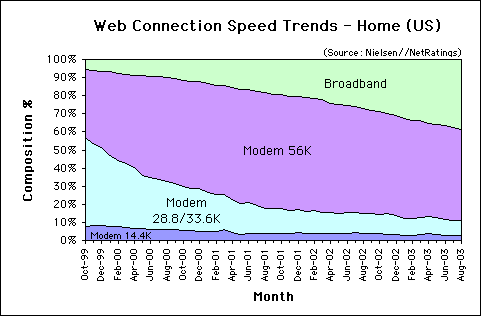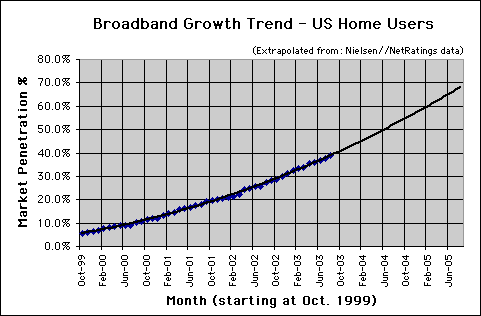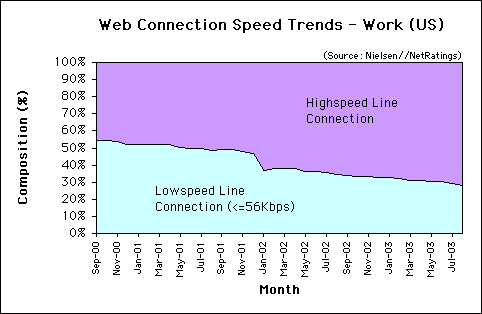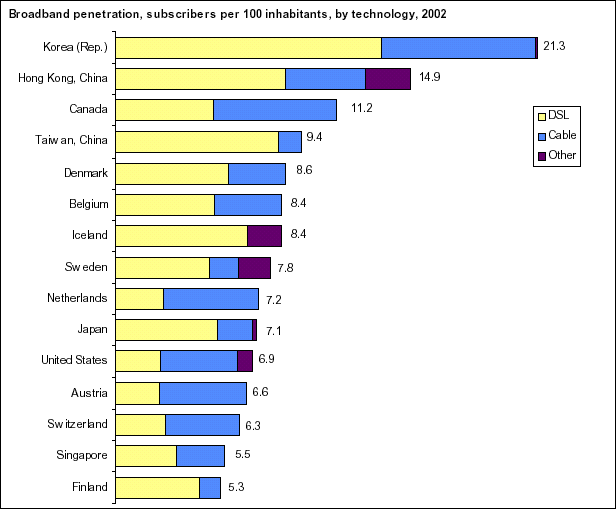Overall, broadband grew by 1.09 percentage points in August, with 38.9% of US home users enjoying a high-speed connection. 61.1% of US home users dial into the Internet with “narrowband” connections of 56Kbps or less.* Korea leads all countries in broadband adoption per 100 inhabitants, while Iceland leads in Internet subscribers per 100 inhabitants.
The charts below, derived from Nielsen//NetRatings and ITU data, show trends in connection speeds to the Internet for users in the United States and the world.
Home Connectivity in the US
As of August 2003, most users in the US connect to the Internet using dial-up modems of 56Kbps or less. 50.3% use 56Kbps modems, 7.9% use 28/33.3Kbps, and 2.9% use 14.4Kbps modems. In total, 61.1% of home users in the US connect to the Internet at 56Kbps or less (see Figure 1).
Web Connection Speed Trends – Home Users (US)
Figure 1: Web Connection Speed Trends – Home Users (US)
Source: Nielsen//NetRatings
Broadband Growth in the US
Broadband penetration in US homes increased by 1.09 percentage points in August. As of August 2003 broadband penetration was at 38.9%, up from 37.8% in July. This is higher than the average increase in broadband of 0.72 percentage points per month from October 1999 to July 2003. Extrapolating the data provided by Nielsen//NetRatings, broadband share in the US should exceed 50% by June of 2004 (see Figure 2).
Broadband Connection Speed Trend – Home Users (US)
Figure 2: Broadband Connection Speed Trend – Home Users (US)
Extrapolated from Nielsen//NetRatings data
Work Connectivity
Most workers in the US enjoy high-speed connections to the Internet. Most use a high-speed line such as a T1 connection, and share bandwidth between computers connected to an ethernet network. The speed of each connection decreases as more employees hook up to the LAN. As of August of 2003, of those connected to the Internet, 72.2% of US users at work enjoy a high-speed connection, up 1.26% from 70.9% in July. 27.8% connect from work at 56Kbps or less (see Figure 3).
Web Connection Speed Trends – Work Users (US)
Figure 3: Web Connection Speed Trends – Work Users (US)
Source: Nielsen//NetRatings
Worldwide Broadband
Worldwide, there were 63 million broadband subscribers at the start of 2003, with 1.13 billion fixed-line users, and 1.16 billion mobile phone users, according to the ITU’s “Birth of Broadband” report. Korea leads all countries with 21.3 subscribers per 100 inhabitants. Hong Kong next (14.9), with Canada (11.2), Taiwan (9.4), Denmark (8.6), Belgium (8.4), Iceland (8.4), Sweden (7.8), Netherlands (7.2), Japan (7.1), United States (6.9), Austria (6.6), Switzerland (6.3), Singapore (5.5), and Finland (5.3) following. The United States has the most broadband subscribers (20 million plus), followed by Korea, Japan, Canada, and Germany (see Figure 4).
Worldwide Broadband Penetration Rates – Top 15 Countries
Figure 4: Worldwide Broadband Penetration Rates – Top 15 Broadband Economies as of end of 2002
Source: The ITU Internet Report: Birth of Broadband, 2003, International Telecommunication Union (ITU). Used with permission.
Worldwide, about one in every ten Internet subscribers has a broadband connection (10.7%). Globally, the type of broadband access is dominated by DSL, which is 20% more popular than cable. Of broadband users connected to the Internet, 59% use DSL while 39% use cable. DSL is more common in Asia and Europe, while cable is more popular in the Americas.
Worldwide Internet Adoption
Iceland leads all countries in Internet users per 100 inhabitants with 60.76%, followed by Sweden (57.31%), Korea (55.19%), Singapore (53.97%), United States (53.75%), Netherlands (53.04%), Finland (50.89%), Norway (50.48%), New Zealand (48.44%), and Canada (48.39%)
Further Reading
- Broadband Usage Limits Enforced
- International Telecommunication Union
- See the Birth of Broadband report (ISBN: 92-61-10351-0, 200 pages, September 2003) for global broadband adoption statistics at the start of 2003.
*Note: “Users” signifies people connected to the Internet.
The Bandwidth Report is featured monthly on URLwire – news of useful and unique web content since 1994.




